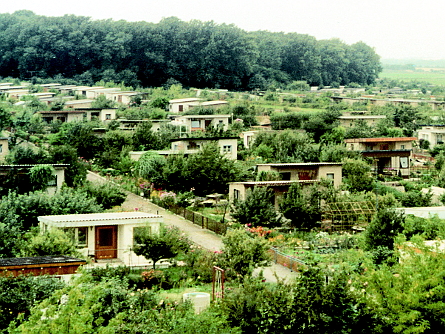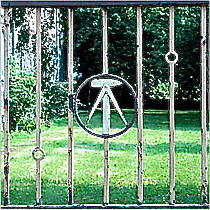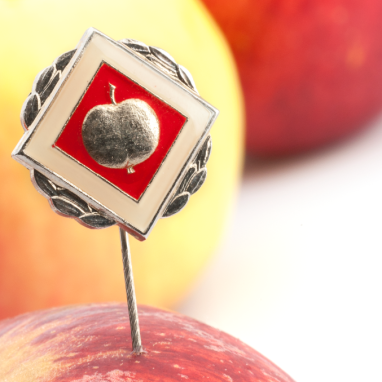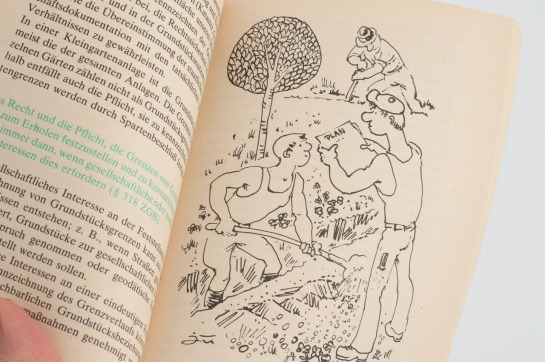Eastern Eden: Allotment Gardens in the GDR
When one travels Germany by rail, the areas directly adjacent to the tracks when one enters and leaves towns and cities are often filled by allotment gardens. Another way Europeans make use of the limited space at their disposal, these gardens are often well tended and incorporate glorified garden sheds (often with tv satellite dishes) which indicate that the plot serves as the owner’s version of a country cottage. Trains I’ve been on have passed close enough to such gardens that I could see owners working away only feet from our carriage or families relaxing around a picnic table seemingly oblivious to the cacophony as we raced by. I soon learned that these plots are cherished sites of recreation for many German urban dwellers whose living arrangements don’t offer them access to any sort of green space.

An East German allotment garden (Thanks for photo to Creative Blog, http://www.thom-blog.de/Wordpress/archives/3945)
The situation was no different in East Germany where such gardens were highly coveted for several reasons. First, having one meant you could produce fruit and vegetables to augment the often meagre selection available in the state shops. This harvest would either end up on gardeners’ own plates or was sold to generate a bit of additional income. Second, allotment gardens were desirable as a refuge from the demands placed on one by by the state and the ruling Socialist Unity Party (SED) and they serve as an example of the fiercely guarded private space which East Germans carved out for themselves and their families, a practice which led some observers to label the GDR a “niche society”.
East Germany as ‘Niche’ Society
This characterization, while useful as a means of understanding the GDR, was not completely uncontroversial. In the East, the SED rejected it as they believed (correctly, I would say) that it implied that the new social order by the Party was not fulfilling its citizens wants and desires. In the West, manifestations of the niche society were frequently pointed to as evidence of East Germans’ opposition to the ruling order.

A homemade wrought-iron fence at an East German allotment garden or datscha featuring the GDR’s state emblem (Thanks for the use of this photo to Zaunwelten – http://www.ddr-zaunwelten.de).
A particularly helpful and informed contribution of the “niche society” discussion was made by Günter Gaus, the Permanent Representative of the Federal Republic to the German Democratic Republic (essentially the West German ambassador to the GDR; it’s a story longer than his title so I’ll just leave it at that) from 1974 to 1981. In his 1983 book Where Germany Lies, Gaus reflected on the his experiences inside of the “niche society” and opined:
“The most beloved of the niches is the allotment garden, if possible with a living space attached . . . At harvest time, the roads to the garden colonies – their names reflecting old yearnings: At Home, Harmony, Land of the Sun – become the favoured promenade of those fellow residents who are not lucky enough to have a garden of their own. Here, flowers, fruit, vegetables sit in buckets and baskets at the garden gates available for private sale.” (Günter Gaus, Wo Deutschland liegt: Hamburg: Hoffman und Campe, 1983, pg. 162)
Gaus appears to accept the interpretation of the “niche society” as an indication of East German society’s shortcomings, but is careful to warn his West German readers not to misunderstand this withdrawal into the private sphere as “oppositional” behaviour:
“Private spaces . . . are by no means the ‘safe houses’ of resistance, but on the contrary, they serve as a vent. It is practically a criterion of middle German [Gaus’ term for East Germany] niches, that their inhabitants have found a degree of happiness by carving out this space and come to an arrangement with the ruling regime of their state. individuals who come in to conflict with the state step out of the niche.” (Ibid, pg. 157)
Gaus continues:
“In this private burrow, you’ll find the average man and his clan, clever enough to demonstrate only as much of the social engagement demanded by the Party and State as is necessary so that nothing stands in his way when he retreats into his private sphere.” (Ibid, pg. 157)
Allotment Gardens – “Part of the Political Organization of the GDR’s Socialist Society”
That many East Germans saw their garden plot as a refugium from the trials of daily life in “real existing socialism” (as SED jargon would have it) was a challenge to Party leaders keen on creating the “new man” which their ideology promised. This attitude naturally made them initially hostile to allotment gardeners and it was not unusual for Party members or media of the 1950s to criticize gardeners for their “petit bourgeois” behaviour. The SED even tried to modify allotment garden culture by taking steps to collectivize such plots when constructing the planned city of Eisenhüttenstadt in the early 1950s. Here, planners included “common orchards” into the blueprints for the new, model city where otherwise allotment plots might have appeared (Parzellen des Glücks – Kleingarten in der DDR, MDR Broadcasting, http://www.mdr.de/damals/archiv/artikel89744.html). When this approach didn’t take, however, the Party backed off.
Official attitudes towards allotment gardens changed dramatically in the 1960s and 70s and then after the SED decided that increasing the number of available gardens was one way to address persistent shortfalls in the quantity of fresh fruits and vegetables available to East Germans.

A silver award pin to honour worthy members of the Federation of Allotment Gardeners, Settlers and Small Animal Breeders, the organization charged with administering allotment gardens and ensuring the implementation of the party line in this context (photo: Jo Zarth).
Indeed, the economic importance of the GDR’s 855,000 allotment gardens can scarcely be underestimated. A handbook for East German gardeners published in 1981 underlined this fact by reporting that “On average, allotment gardens and small animal breeders provide 1/3 of all fruit, 1/10 of all vegetables, 2/5 of eggs and all the honey available in East German shops each year. . . In this way, allotment gardeners and small animal breeders contribute to the increase in our Republic’s economic activity.” (Ernst Pannach, Kleine Gärten, grosser Nutzen – Small Gardens of Great Utility: Berlin: Staatsverlag der DDR , 1981, pg. 8).
(Interestingly, Günter Gaus touches on the economic aspect of these gardens in his book. Here he laments how West German observers tend to mock the East Germans for their practice of including the production of allotment gardens when they present their yearly economic data (“Look, they have to count every stalk of rhubarb just so the figures are presentable!” (Gaus, pg. 163) without any consideration of what their inclusion says about the difficulties facing their brothers and sisters across the Wall on a daily basis. A nice observation on the state of German-German relations in the year 1983.)
Naturally, the Party was careful to create an organizational structure which gave it complete control over the plots and would-be gardeners. The Association of Allotment Gardeners, Settlers and Small Animal Breeders (VKSK) became the “transmission belt” for SED policies in the allotment garden context. However, here as in other part of the GDR, the Party’s aims sometimes exceeded its actual reach. In Lutz Niethammer’s excellent oral history of the GDR, Die volkseigene Erfahrung – The People’s Own Experience (Berlin: Rowohlt, 1991), one interview sheds some interesting light on the political reality within an allotment garden colony near the Saxon industrial city of Karl-Marx-Stadt (once again known as Chemnitz) in the late 1980s. In an interview with a 77 year-old pensioner we learn from Niethammer that the man was the long time chair of his garden colony until he was forced out of the position on age grounds several years previous. Apparently, the man had been a popular chair in that he was pragmatist adept at balancing the demands of the Party with the desire of most gardeners to have their plot remain a place of retreat from everyday life. The interviewee relates that in his place the SED had installed one of its members who’d taken early retirement from his job organizing “socialist competition” in workplaces. Under their new chair, gardeners were now being pressured to pledge increased fruit and vegetable production, something the retiree reports his fellow gardeners have “had it up to here with at their jobs!” Even worse, the new man uses colony meetings to give long political speeches and so few bother to attend these anymore. The results of the SED’s attempts to impose its politics? “Now nothing runs as it should.”, offers the pensioner (Niethammer, pg. 152.). It’s hard to find a more telling anecdote of the socio-political climate in late stage GDR than the one depicted here.

Under Construction: a cartoon from 1981 handbook for East German allotment gardeners (photo: Jo Zarth).
A second anecdote underscoring how allotment gardens worked as somewhat imperfect places of retreat is found in the memoir by Robert Ide, a Berlin newspaper journalist. Ide was born in 1975 and uses his book Geteilte Träume: Meine Eltern, die Wende und ich – Divided Dreams, My Parents, the Wende and Me (Munich: btb Verlag, 2009) to explore the generational divide brought on by German reunification. As part of this, he relates how his family came to be tenants of one of 212 plots in “Allotment Garden Rosenthal South”, a project begun in 1979 as part of the GDR government’s plan “One Hundred Thousand New Allotment Gardens”. Would-be tenants of the colony were charged 400 Marks and required to provide 150 hours of labour towards the creation of the gardens. This was not simply a case of mowing grass and the like but laying plumbing, pouring foundations, etc. The location of this garden was interesting in that it ran directly parallel to the Wall in the northeast of the eastern part of the city. Across the border stood the high rises of one of West Berlin’s many post-war residential districts, the Märkisches Viertel (or Quarter). Despite this somewhat bizarre location, Ide describes the plot as a genuine refuge for his family:
“Regeneration on the Wall strip had its advantages. It was wonderfully quiet. There was no need to lock up when one left as thieves went elsewhere, just to be on the safe side. And after a few years the fruit trees had grown high enough that, if one sat in the shaded corner of the plot, the border was no longer visible. In late summer, the watch towers were obscured by apples and peaches.” (Ide, pg. 78)

Members of the Allotment Garden Colony “Carefree” meet for a group meal in the early 1980s. This garden was created on the edge of Marzahn, a district in East Berlin and the GDR’s largest ‘socialist suburb,’ as part of the government’s attempts to address persistent produce shortages (Thanks to Kleingarten e.V. “Sorgenfrei” for permission to reproduce this photo here.)
Reality was never too far away, however, as Ide recalls:
“During the day, the wind would blow over the noises from a public pool on the other side of the Wall, while nighttime was punctuated by the barking of the guard dogs , , , The high rises, just a few meters away, but unreachable for anyone on this side, showed us weekend after weekend how something unnormal seemed to become ever more normal. But without ever becoming completely so.” (Ide, pgs. 78-79)
Fence Worlds: Solidarity and Creativity Behind and On the Garden Fence
In preparing this post, I came across Zaunwelten, or Fence Worlds, a fantastic project put together by Majken Rehder and Nicole Andries, two project managers active in media and cultural fields in Berlin, and one which involved a touring exhibition and book publication. At the heart of the project project stands an examination of the homemade wrought-iron garden fences found in East German allotment gardens, datschas and homes. Rehder and Andries show how, in an economic environment where finding a garden fence was not a simple matter of heading to the building supply store, these structures and the stories of their creation can serve to examine a myriad of aspects of everyday life in East Germany. As Rehder offers in the book, the constant shortages in consumer goods helped make the GDR a flourishing home of DIY culture, something that had a great impact on the way people related to, and needed, one another.
“Next to the state’s planned economy, a parallel economy which turned on informal trade, personal initiative, Western contacts and the ingenuity of residents also flourished in the GDR. It was up to individuals to be creative, improvise and make what could not otherwise be found. Out of this, activities which once were the domain of hobbyists gradually evolved into a sort of emergency economic plan.” (Rehder, Zaunwelten. Zäune und Zeitzeugen, Marburg: Jonas Verlag, 2005)
One particularly interesting section of the book entitled “Country of Borders and Fences: Wall-Land” looks at the relationship between these fences and the Wall. In it, Nicole Andries argues:
“[. . .] through the creation of garden fences with their focus on a beautifying-decorative element, the horrifying/sublime nature of the experience with the Wall is overcome, to an extent – the monster is tamed, it is domesticated. The self-made garden fences are less the expression of a “barrier neurosis” or the blind repetition of a trauma than a form of processing and creative sublimation. Here the fences are not be understood as mimetic copies of the Wall, but rather in the process of appropriating the Wall theme, this undergoes a sort of aesthetic reversal. The self-made garden fences of the GDR are the positive-aesthetic opposite of the Wall.” (Andries, Zaunwelten. Zäune und Zeitzeugen, Marburg: Jonas Verlag, 2005)
The slideshow found above is taken from photos used in the Zaunwelten project and are included here thanks to the kind permission of Majken Rehder and Nicole Andries. Thanks for the support! It’s worth taking the time to have a look at these and interesting to note that many of them, particularly those using somewhat unconventional geometric shapes and patterns, were made using by-products of industrial processes.
For those of you who read German, you’ll find an interesting piece about the Zaunwelten project in Spiegel Online at this link.


This was a great piece!
Thanks for taking the time to read it! I’m glad you enjoyed it.
jpk
Being completely honest, all I saw were the extremely low fences between allotments in the first picture in the article. I am hugely impressed, as an allotment gardener of 20 years plus in England, there are no allotments like this locally. Most have high fences and are occupied by mistrustful people.
Luckily I seem to have found a site where folks at least communicate with each other. I’m hoping to promote some kind of allotment community there. Organising things that we could all use (manure and compost deliveries etc) and promoting an organic method of growing fruit, vegetables and herbs. These gardens were meant to be shared and promote community interest. The picture and comments on this site promote a more socially aware and caring garden/allotment site, I only hope I can achieve this. Can’t wait to see what this year brings.
Pingback: “Free Body Culture”: Nudity, me and Eastern Germany | The GDR Objectified
Pingback: FKK in der DDR, and a link between naturism and authoritarianism? | the sl naturist
Pingback: 40 Things I Saw on the Deutsche Bahn. - My Meena Life